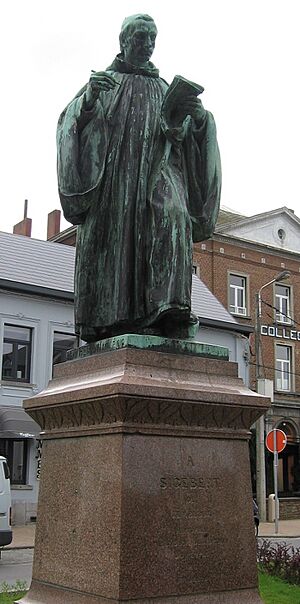Sigebert of Gembloux facts for kids

Sigebert of Gembloux (born around 1030 – died October 5, 1112) was an important writer and historian from the Middle Ages. He was known for writing a very long history book called a "universal chronicle." Sigebert often disagreed with the powerful popes of his time, like Pope Gregory VII and Pope Pascal II. Early in his life, he joined a group of monks called the Benedictines at the abbey of Gembloux.
Early Life and Teaching Career
Sigebert was born near a town called Gembloux, which is now in Belgium, around the year 1030. He likely came from a Latin-speaking family, not a Germanic one. He studied and grew up at the Gembloux Abbey, where he later became a monk when he was still young.
For a long time, Sigebert worked as a teacher at the Abbey of St. Vincent in Metz. Around 1070, he returned to Gembloux. Everyone admired him for his knowledge. He was in charge of the abbey school there until he died. He spent his time teaching students and writing many books.
Sigebert and the Popes
After returning from Metz, Sigebert became a strong supporter of the Holy Roman Emperor. This was a time when there was a big fight between the Emperor and the Pope. This conflict is known as the Investiture Controversy. It was about who had the power to appoint important church leaders.
Sigebert did not agree with the Pope's growing power. He took part in the big argument between Pope Gregory VII and Emperor Henry IV. Sigebert wrote several papers to support the Emperor's side. One of these papers, which is now lost, was a reply to Pope Gregory VII. The Pope had claimed he could remove kings from power and free their subjects from their loyalty oaths.
Sigebert also defended priests who were married. Pope Gregory VII had forbidden people from attending church services led by married priests. Later, when Paschal II told a count to fight against people who supported the Emperor, Sigebert said this was wrong. He believed it was not Christian and went against what the Bible taught.
Sigebert passed away at Gembloux on November 5, 1112.
Sigebert's Writings
Sigebert's most famous work is his Chronicon sive Chronographia, which means "Chronicle or Chronography." This was a "universal chronicle," a history book that tried to cover events from the very beginning of time. Many people thought it was the best history book of its kind.
His chronicle covered events from the year 381 to 1111. It showed that Sigebert was a very learned person. The book became a main source of information for churches and abbeys in Belgium and northern France. Many copies of the book were made, and it was used by many other writers. After Sigebert died, another monk named Anselm of Gembloux continued his chronicle.
The original handwritten copy of Sigebert's chronicle is kept safe in the Royal Library of Belgium.
Sigebert wrote other important works too:
- A life story of the Frankish king Sigebert III, who founded a monastery in Metz.
- A biography of Bishop Theodoric I of Metz.
- A long poem about the martyrdom of St. Lucy.
- A long poem about the Theban Legion, a group of Christian soldiers.
- A history of the early leaders (abbots) of Gembloux Abbey.
- A list of 171 church writers and their works, called De scriptoribus ecclesiasticis. In this list, he even mentioned his own writings!
Sigebert also wrote about the lives of saints, which is called hagiography. He revised the life stories of St. Maclovius and two early bishops of Liège, Theodard of Maastricht and Lambert of Maastricht. He also wrote about Dietrich, bishop of Metz and Wicbert, who founded the abbey of Gembloux.

